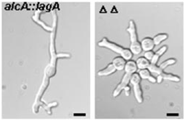Department of Chemistry
Document Type
Article
Date of this Version
July 2001
Abstract
CYP83B1 from Arabidopsis thaliana has been identified as the oxime-metabolizing enzyme in the biosynthetic pathway of glucosinolates. Biosynthetically active microsomes isolated from Sinapis alba converted p-hydroxyphenylacetaldoxime and cysteine into S-alkylated p-hydroxyphenylacetothiohydroximate, S-(p-hydroxyphenylacetohydroximoyl)-L-cysteine, the next proposed intermediate in the glucosinolate pathway. The production was shown to be dependent on a cytochrome P450 monooxygenase. We searched the genome of A. thaliana for homologues of CYP71E1 (P450ox), the only known oxime-metabolizing enzyme in the biosynthetic pathway of the evolutionarily related cyanogenic glucosides. By a combined use of bioinformatics, published expression data, and knock-out phenotypes, we identified the cytochrome P450 CYP83B1 as the oxime-metabolizing enzyme in the glucosinolate pathway as evidenced by characterization of the recombinant protein expressed in Escherichia coli. The data are consistent with the hypothesis that the oxime-metabolizing enzyme in the cyanogenic pathway (P450ox) was mutated into a “P450mox” that converted oximes into toxic compounds that the plant detoxified into glucosinolates.



Comments
Published in The Journal of Biological Chemistry 276:27 (July 6, 2001), pp. 24790–24796. doi:10.1074/jbc.M102637200 Copyright © 2001 by The American Society for Biochemistry and Molecular Biology, Inc. Used by permission.